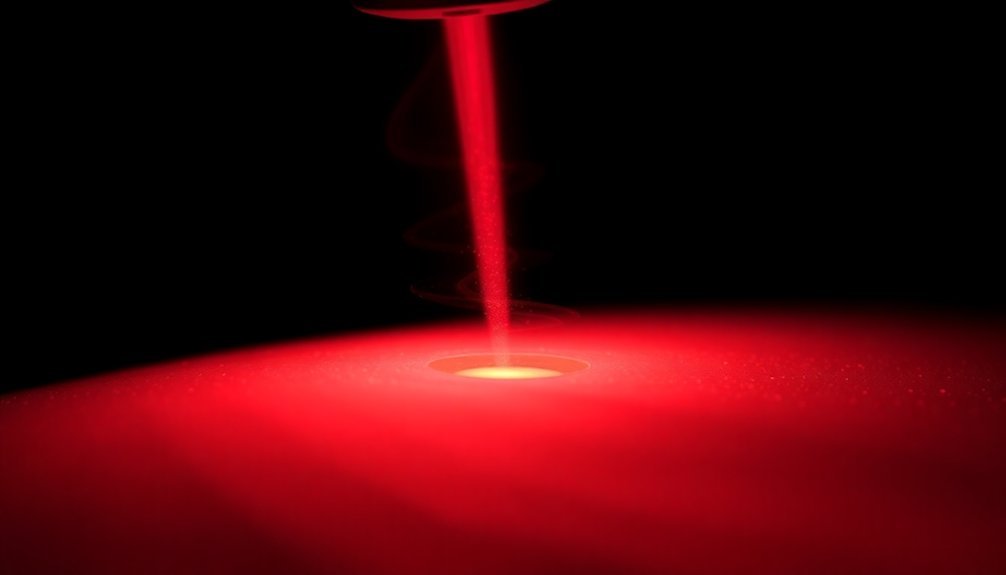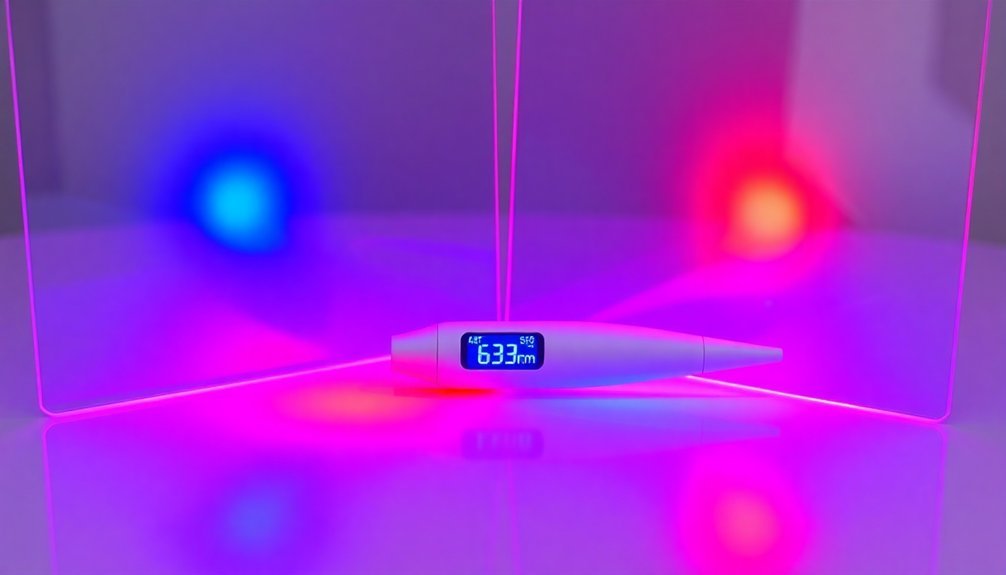You'll find five wavelengths particularly effective for treating acne: blue light (415nm), red light (650nm), infrared (1450nm), green light (532nm), and combined blue-red therapy. Each wavelength targets different aspects of acne – blue light kills bacteria, red light reduces inflammation, infrared shrinks oil glands, and green light decreases sebum production. The most impressive results come from combined blue-red therapy, showing up to 77.93% improvement in non-inflammatory lesions and 34.28% in inflammatory lesions. With minimal side effects and proven clinical results, these light therapies offer powerful alternatives to traditional acne treatments. Understanding how each wavelength works can help you choose the most suitable option for your skin concerns.
Blue Light at 415nm

Light-wielding dermatologists have found their weapon of choice in blue light therapy at 415nm. This specific wavelength targets P. acnes bacteria through a process called endogenous photodynamic therapy, where bacterial porphyrins absorb the light and create oxygen species that destroy the bacteria.
You'll find that 415nm blue light penetrates just deep enough to reach acne-causing bacteria near your skin's surface while minimizing damage to surrounding tissue. Typical sessions last 15-30 minutes, making it a convenient treatment option.
When combined with red light therapy, it's proven more effective than traditional treatments like 5% benzoyl peroxide cream, particularly at the 8 and 12-week marks.
While you can access this technology through both professional treatments and home devices, it's important to maintain realistic expectations. The therapy works best for mild to moderate acne, and you might need ongoing treatments to maintain results.
You won't typically experience significant adverse effects, but there's a slight risk of hyperpigmentation with 415nm wavelengths.
If you're considering this treatment, you'll want to know that newer devices sometimes use longer wavelengths (around 465nm) to reduce hyperpigmentation risks while maintaining effectiveness against acne-causing bacteria.
Red Light at 650nm
Through advanced research, red light therapy at 650nm has emerged as a powerful tool in the fight against acne. This wavelength penetrates deep into your skin, targeting sebaceous glands and inflammatory mediators that contribute to breakouts. You'll find it's particularly effective at reducing both non-inflammatory and inflammatory lesions, showing improvements of 19.5% and 24.4% respectively in mild to moderate acne cases. Studies have shown that wavelengths between 600 and 650 nm provide optimal skin penetration depth.
When you undergo red light therapy, you're benefiting from its ability to accelerate wound healing and decrease inflammation. It works by reducing inflammatory mediators from macrophages and lowering levels of neutrophils and interleukins.
You'll also experience enhanced collagen production and improved circulation, which contribute to overall skin health.
You can use red light therapy alone or combine it with blue light for better results. It's generally safe, though you might experience minor side effects like dryness or itching.
While home devices are available, you'll want to consult a doctor first to avoid potential misuse. This treatment offers a safer alternative to more aggressive options like photodynamic therapy, making it an attractive choice for long-term acne management.
Infrared at 1450nm

When targeting stubborn acne, infrared light at 1450nm stands out as one of the most potent wavelengths available. You'll see impressive results with just one treatment, achieving a 42.9% reduction in acne lesions, while three treatments can boost that number to 75.1%. What's remarkable is that these results aren't temporary – studies show a 76.1% reduction persisting even after 12 months. This wavelength can be effectively combined with PDT to enhance treatment outcomes.
The magic happens as the 1450nm wavelength precisely targets water in your sebaceous glands. This creates a controlled thermal effect that reduces sebum production and inflammatory acne lesions. You'll experience minimal discomfort thanks to the dynamic cooling device used during treatment.
| Treatment Aspect | Results | Timeline |
|---|---|---|
| Single Session | 42.9% reduction | Immediate |
| Three Sessions | 75.1% reduction | Post-treatment |
| Long-term Results | 76.1% reduction | 12 months |
| Side Effects | Minimal erythema | Temporary |
| Skin Types | All types I-VI | Immediate |
Clinical studies confirm the laser's effectiveness for moderate to severe acne, with sustained improvements in both active acne and scarring. You'll typically notice significant reductions in sebum production and lasting improvements in skin texture.
Green Light at 532nm
Green light therapy at 532nm delivers promising results for mild to moderate acne sufferers, offering a gentle yet effective treatment option. Clinical studies have shown it can reduce acne lesions by up to 36% within just one month, while also decreasing sebum production by 28%.
You'll find this treatment works through photobiomodulation, where the light penetrates your skin and targets specific cells. The 532nm wavelength specifically targets porphyrins, creating reactive oxygen species that kill acne-causing bacteria while reducing inflammation and promoting healing in both inflammatory and non-inflammatory lesions. For optimal results, treatments should be conducted 2-3 times weekly for 15-30 minutes per session.
What makes green light particularly appealing is its versatility and safety profile. You won't need to worry about significant side effects, as it's well-tolerated and non-invasive.
While blue light might be more effective at killing bacteria, green light excels at reducing inflammation and can even help with related skin concerns like rosacea and hyperpigmentation.
Clinical trials support these benefits, with studies showing similar results whether you use it once or twice weekly. You can easily incorporate this treatment into your existing skincare routine, making it a practical choice for those seeking a gentle yet effective acne solution.
Combined Blue-Red Light Therapy

Have you considered combining the power of two distinct wavelengths for maximum acne-fighting results? The combination of blue (415 nm) and red (650 nm) light therapy offers a powerful solution for treating mild to moderate acne vulgaris. This dynamic duo works synergistically, with blue light targeting P. acnes bacteria while red light reduces inflammation and promotes healing. For optimal results, treatment sessions should be spaced two weeks apart, following professional protocols.
| Benefit | Blue Light (415nm) | Red Light (650nm) |
|---|---|---|
| Primary Action | Destroys bacteria | Reduces inflammation |
| Skin Depth | Surface level | Deeper penetration |
| Clinical Results | 34.28% improvement in inflammatory lesions | 77.93% improvement in non-inflammatory lesions |
You'll find this combination therapy particularly effective because it's non-invasive, painless, and safe – even during pregnancy. Clinical studies show it outperforms blue light alone and compares favorably to traditional treatments like benzoyl peroxide. While you might experience minor side effects like dryness or itchiness, they're generally well-tolerated. The treatment protocol typically involves multiple sessions over several weeks, and you can even self-administer with proper guidance from your dermatologist.
Frequently Asked Questions
How Long Should I Wait Between Different Light Therapy Sessions?
You'll want to wait 24-48 hours between light therapy sessions. If you're doing at-home treatments, stick to 2-3 sessions weekly, spacing them out evenly throughout the week for best results.
Can I Use Light Therapy While Taking Oral Acne Medications?
You can use light therapy while taking oral acne medications, but you'll need to consult your dermatologist first. Some medications may increase light sensitivity, so professional guidance is essential for safe, effective treatment.
Does Skin Color Affect the Effectiveness of Light Treatments?
Yes, your skin color can affect light treatment results. While red light works well for all skin types, blue light may be less effective on darker skin since melanin absorbs more light energy.
Are At-Home Light Therapy Devices as Effective as Professional Treatments?
While at-home devices can be effective, they're typically less powerful than professional treatments. You'll likely see improvements, but results may take longer and be less dramatic than what you'd get at a clinic.
Can Light Therapy Prevent Future Acne Breakouts After Clearing Existing Ones?
Yes, you'll find light therapy can help prevent future breakouts by killing P. acnes bacteria, reducing inflammation, and decreasing sebum production. Regular treatments with blue and red light maintain these preventive benefits long-term.
In Summary
You'll find that light therapy offers multiple effective wavelength options for treating your acne. Whether you choose blue light for its bacteria-killing properties, red light for inflammation reduction, infrared for deep penetration, green light for hyperpigmentation, or a combined approach, there's a scientifically-backed solution for your skin concerns. Consider discussing these options with your dermatologist to determine which wavelength best suits your specific acne type.





Leave a Reply